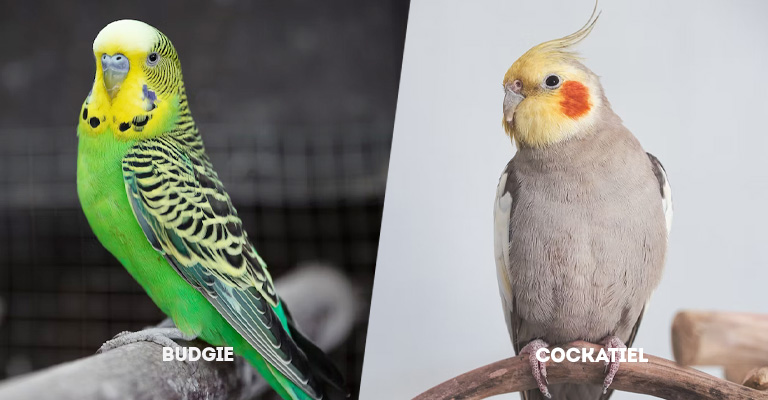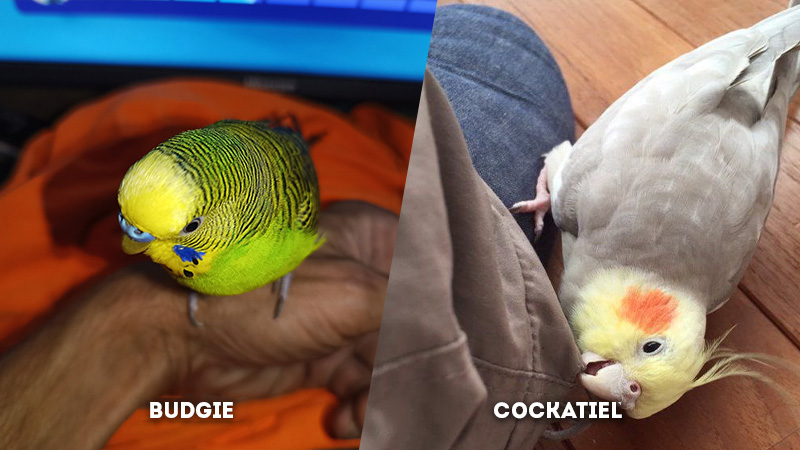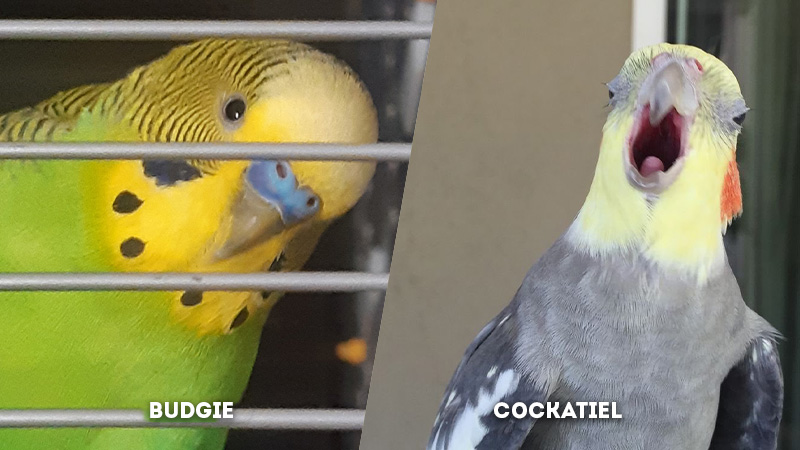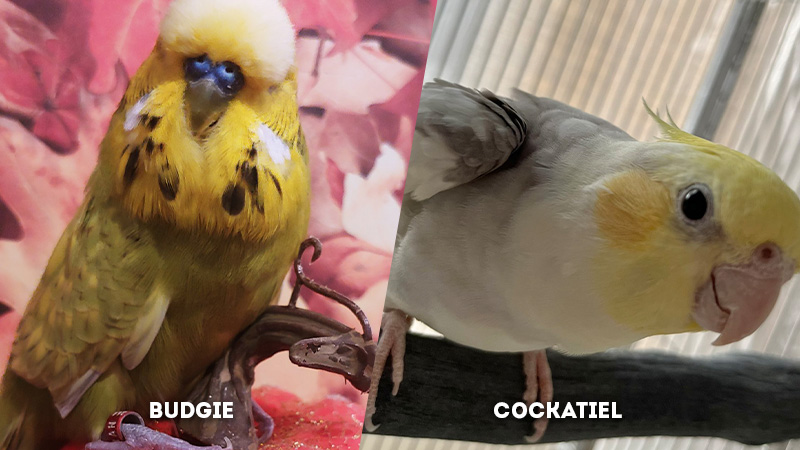Choosing the perfect avian companion brings joy and a sense of responsibility. Among the array of options, budgies and cockatiels stand out as beloved choices.
These charming birds offer distinct characteristics that resonate with different personalities and lifestyles. Delving into their attributes provides insights into their unique qualities and the companionship they offer.
This exploration uncovers the captivating world of budgies and cockatiels, shedding light on their playful behaviors, social interactions, vocal abilities, grooming rituals, dietary preferences, and the bonds they form with their human companions.

Key Differences Between Budgie and Cockatiel
Budgies and cockatiels are both popular pet birds that are often chosen by bird enthusiasts. While they share some similarities, they also have several key differences.
Here are some of the main differences between budgies and cockatiels:
Personality Traits
- Budgie: Budgies are known for their high energy levels and playful demeanor. These birds exude curiosity and are constantly exploring their surroundings.
They often engage in playful antics and interact with toys, making them a great choice for individuals seeking a lively and active companion. - Cockatiel: On the other hand, cockatiels are recognized for their low-key and affectionate personality. These birds thrive on physical interaction and enjoy being touched by their owners.
Cockatiels are known to develop deep bonds with their human caregivers, making them a suitable choice for those who cherish close companionship.
Interaction Preference
- Budgie: Budgies are social birds that may perch on a finger but are generally not inclined towards extensive physical touching. They enjoy being around their owners, perching on their fingers, and occasionally interacting with toys. However, they might not seek out as much physical contact as some other species.
- Cockatiel: Cockatiels, in contrast, are touchy-feely birds that relish human touch. They actively seek out physical interactions, such as head scratches and cuddles. This affectionate nature makes cockatiels a wonderful option for individuals who desire a bird that loves to be close and nurtured.
Behavior

- Budgie: Budgies showcase vibrant and playful behavior. They are quick learners, often picking up tricks and mimicking sounds. Their active demeanor and social nature make them delightful to watch and engage with. Budgies tend to exhibit curious behavior and enjoy exploring their environment.
- Cockatiel: Cockatiels exhibit a calm and content behavior. They are less energetic than budgies but make up for it with their gentle and affectionate demeanor. Cockatiels are known for their whistling abilities and may occasionally talk, showcasing their intelligent and adaptable nature.
Size
- Budgie: Budgies are smaller in size compared to cockatiels. Their petite stature makes them suitable for those with limited space. Their smaller size also contributes to their energetic flight patterns and playful behavior.
- Cockatiel: Cockatiels are larger than budgies, and their size is characterized by their prominent crest on their heads. This size difference translates to a slightly more relaxed and easygoing flight pattern, aligning with their calmer personality.
Lifespan
- Budgie: The lifespan of a budgie generally ranges from 10 to 15 years. While their time with their human companions might be slightly shorter, budgies bring a burst of energy and joy during their years together.
- Cockatiel: Cockatiels, with their longer lifespan of 15 to 20-plus years, provide the opportunity for an extended companionship journey. Their affectionate nature and close bonding with owners create lasting memories over the years.
Vocalizations

- Budgie: Budgies are renowned for their chatty and active vocalizations. These tiny birds have the remarkable ability to mimic various sounds, including human speech, phone rings, and other environmental noises. Their lively vocal repertoire often brings a playful and vibrant atmosphere to their surroundings.
- Cockatiel: In contrast, cockatiels are more inclined towards whistling and occasional talking. While they may not exhibit the extensive mimicry seen in budgies, their whistles and unique sounds add a touch of musical charm to their interactions with both their owners and their environment.
Colors and Markings
- Budgie: Budgies come in a wide array of colors, often displaying vibrant hues that catch the eye. Their feathers can range from bright blues, greens, and yellows to more subtle pastel shades. Their intricate color variations contribute to their visual appeal and unique charm.
- Cockatiel: Cockatiels sport distinctive markings, including their iconic crest on the head. Their color palette, while not as extensive as that of budgies, features subtle and enchanting hues. The combination of their crest and softly patterned plumage adds an element of elegance to their appearance.
Learning Ability
- Budgie: Budgies are quick learners known for their impressive cognitive abilities. They have the capacity to pick up tricks, mimic sounds, and even learn basic words and phrases. Their aptitude for learning adds an element of interaction and engagement, making them well-suited for mentally stimulating activities.
- Cockatiel: Cockatiels also possess good learning abilities, though they might not exhibit the same level of mimicry as budgies. They can learn various tunes and respond to their names, showcasing their intelligence and adaptability.
Interaction With Humans
- Budgie: Budgies have a social nature and enjoy perching on fingers, interacting with their owners from a close proximity. While they may not be as touchy-feely as cockatiels, their willingness to perch on fingers and engage in playful activities creates a sense of companionship.
- Cockatiel: Cockatiels, known for their affectionate personality, actively seek out interaction with humans. They enjoy physical touch, such as head scratches and gentle strokes. This close bonding and physical affection contribute to the deep connections they form with their human caregivers.
Handling Preference
- Budgie: Budgies are generally less inclined towards extensive handling and touching. While they might perch on fingers and enjoy being near their owners, they may not actively seek out physical contact beyond perching.
- Cockatiel: On the other hand, cockatiels thrive on handling and physical interaction. They revel in the touchy-feely aspect of companionship, often nuzzling their owners and enjoying close cuddles. Their comfort with being handled makes them a great choice for those who value hands-on interaction.
Playfulness
- Budgie: Budgies exhibit a dynamic and vibrant playfulness. They are renowned for their energetic antics and curious behavior. Budgies engage with toys, mirrors, and interactive items, infusing their environment with a playful aura that appeals to those seeking a lively and active companion.
- Cockatiel: Cockatiels showcase a different form of playfulness, often characterized by their gentle interactions. While they might not be as active as budgies, cockatiels enjoy spending quality time with their owners, indulging in head scratches, cuddles, and moments of bonding that create a heartwarming playfulness.
Bonding With Owner
- Budgie: Budgies have the remarkable ability to develop strong bonds with their human caregivers. Their social nature enables them to form close connections, often seeking out interaction and companionship. These bonds contribute to a sense of camaraderie and shared experiences.
- Cockatiel: Cockatiels, with their affectionate demeanor, excel in forming deep and lasting bonds with their owners. Their touchy-feely nature and inclination towards physical interaction create a sense of attachment and loyalty, making them cherished companions.
Grooming Behavior
- Budgie: Budgies are diligent groomers, spending a significant amount of time preening and caring for their feathers. This behavior not only maintains their plumage’s health and appearance but also showcases their meticulous nature.
- Cockatiel: Similarly, cockatiels are meticulous groomers. Their rituals involve preening their feathers and maintaining their crest, reflecting their inherent grooming instincts and contributing to their overall well-being.
Crest or Feathers

- Budgie: Budgies don’t possess a prominent crest. However, their vibrant and varied feather colors and patterns contribute to their visual appeal. Their colorful plumage adds a touch of vibrancy to their presence.
- Cockatiel: Cockatiels are instantly recognizable by their prominent crest on the head. This crest serves as a communication tool, reflecting their emotional state and providing insight into their interactions and mood.
Dietary Preferences
- Budgie: Budgies have diverse dietary preferences, including seeds, fruits, and vegetables. Offering a balanced diet is crucial for their well-being, as it ensures they receive the necessary nutrients for a healthy and active life.
- Cockatiel: Cockatiels also have dietary preferences that encompass a mixture of seeds, pellets, fruits, and vegetables. Their nutritional needs are diverse, emphasizing the importance of providing a well-rounded diet to support their overall health.
Avian Companionship
- Budgie: Budgies are naturally gregarious and thrive in the company of other budgies. While they can form close bonds with their human caregivers, their social nature often makes them happier when they have avian companionship.
Keeping budgies in pairs or small groups can provide them with a fulfilling social environment that mimics their natural habitat. - Cockatiel: Cockatiels are known for their strong emotional connections with their human owners. While they also appreciate the company of their fellow cockatiels, their affinity for forming deep bonds with humans often makes them feel like cherished members of the family.
Their ability to develop strong attachments contributes to the heartwarming companionship they offer.
Social Behavior
- Budgie: Budgies are highly social birds that thrive in flocks. Their energetic interactions within the flock contribute to their vibrant and playful behavior. In a human household, budgies can display similar social behaviors by engaging with toys, exploring their environment, and interacting with their human companions.
- Cockatiel: Cockatiels also have social tendencies, although they exhibit them differently. They are known for their affectionate behavior and their inclination to seek out physical contact with their human caregivers. Cockatiels often bond deeply with their owners and enjoy being part of the family’s daily interactions.
Learning Speech and Sounds
- Budgie: Budgies are renowned for their remarkable ability to mimic speech and sounds. With proper training and interaction, they can learn to repeat words, phrases, and even imitate various sounds from their environment. This mimicry adds an element of interaction and entertainment to their companionship.
- Cockatiel: Cockatiels possess the capacity to learn and mimic tunes and sounds, although their speech abilities might not be as extensive as those of budgies. They often whistle and make unique sounds that reflect their individual personalities, contributing to the auditory richness of their presence.
Noise Level
- Budgie: Budgies are known for their chatty and active vocalizations. While their mimicry and vocal interactions can create a lively atmosphere, they might be more vocal than some other companion bird species. Their cheerful chatter adds a layer of vibrancy to their surroundings.
- Cockatiel: Cockatiels produce a mix of whistling, chirping, and occasional talking. While their noise level might be slightly lower compared to budgies, they can still contribute to the auditory ambiance of the household. Their melodic whistles and unique vocalizations often endear them to their human companions.
Cage and Space Requirements
- Budgie: Due to their smaller size, budgies have more lenient cage and space requirements. They are well-suited for apartment living and environments with limited space. However, providing ample room for flight and exploration is essential for their well-being and mental stimulation.
- Cockatiel: Cockatiels, being slightly larger, require a more spacious cage and environment. Their active nature benefits from having enough room for flying, climbing, and playing. Offering a larger cage with toys and perches ensures their physical and mental engagement.
Loyalty to Owners
- Budgie: Budgies can develop strong bonds with their human caregivers, but their social nature might also lead them to bond closely with other budgies. While they enjoy human interaction, their loyalty might be distributed among both humans and avian companions.
- Cockatiel: Cockatiels are known for their exceptional loyalty and affection towards their human owners. They form deep and enduring attachments, often choosing their human companions as their primary source of social interaction and companionship.
Budgie Vs Cockatiel: Comparison Table
| Aspect | Budgie (Budgerigar) | Cockatiel |
|---|---|---|
| Personality Traits | High energy, playful, active | Low key, affectionate, touchy-feely |
| Interaction Preference | Perches on finger, less fond of touching | Enjoys physical interaction and being touched |
| Behavior | Playful, curious, social | Calm, content, less energetic |
| Size | Smaller | Larger |
| Lifespan | 10 to 15 years | 15 to 20-plus years |
| Vocalizations | Chatter, mimicry, singing | Whistling, occasional talking |
| Colors and Markings | Varied colors, often vibrant | Distinctive crest, subtle color variations |
| Learning Ability | Quick learners, can be taught tricks | Good learners, can mimic sounds |
| Interaction with Humans | Perches on finger, social, less tactile | Affectionate, enjoys physical contact |
| Handling Preference | Less fond of extensive handling | Comfortable with handling |
| Playfulness | Very playful, enjoys toys and activities | Playful, may enjoy interacting with toys |
| Bonding with Owner | Develops strong bonds with owners | Forms strong bonds with owners |
| Grooming Behavior | Prone to preening and grooming feathers | Prone to grooming and preening feathers |
| Crest or Feathers | Short crest on head | Prominent crest on head |
| Dietary Preferences | Seeds, fruits, vegetables | Seeds, pellets, vegetables, and fruits |
| Avian Companionship | Can live with other budgies | Can live with other cockatiels or birds |
| Social Behavior | Flocks, social with other birds | Social, enjoys interacting with humans |
| Learning Speech and Sounds | Good at mimicking sounds and speech | Capable of learning and mimicking sounds |
| Noise Level | Chatty, active vocalizations | Whistling, occasional loud calls |
| Cage and Space Requirements | Smaller cage size is suitable | Larger cage size may be necessary |
| Loyalty to Owners | Form strong bonds with owners | Display loyalty and affection to owners |
Frequently Asked Questions
While it’s possible to keep budgies and cockatiels together, it’s generally recommended to house them separately. These species have different social behaviors and space requirements. Additionally, housing them together might lead to dominance issues or stress for one of the species. Providing each species its own appropriate-sized cage ensures their well-being and happiness.
Both budgies and cockatiels use body language to communicate. For instance, when a cockatiel’s crest is raised, it might indicate curiosity or excitement. Budgies might bob their heads or spread their wings to convey various emotions. Observing these physical cues helps in understanding your bird’s mood and feelings.
Yes, both species are trainable and can learn tricks with patience and positive reinforcement. Budgies are particularly known for their quick learning abilities and mimicry, making them adept at learning tricks like stepping onto your finger or playing with toys. Cockatiels can also learn tricks and respond well to training that aligns with their social and curious nature.
While both species are social, their companionship needs vary. Budgies are highly social birds that benefit from the company of other budgies. Cockatiels also appreciate their own species’ company, but they can form deep bonds with their human caregivers. A well-socialized and engaged human companion can often fulfill a cockatiel’s need for interaction.
When introducing a new budgie or cockatiel to your home, it’s essential to provide a suitable quarantine period to ensure the bird’s health. Gradually acclimate the bird to its new surroundings, offering a quiet and stress-free environment. Slowly introduce interaction while respecting the bird’s comfort zone. Supervised and gradual introductions to existing pets or other birds can also help in fostering positive relationships.
To Recap
In the vibrant tapestry of avian companionship, budgies and cockatiels emerge as remarkable choices, each with its own set of endearing qualities.
Whether you’re drawn to the lively chatter of budgies or the affectionate nature of cockatiels, these birds have the power to create lasting bonds that enrich lives.
Through their playful antics, melodic tunes, and unique interactions, they become cherished members of households.
The decision between these two avian friends ultimately reflects the alignment of personalities, preferences, and the desire for a fulfilling companionship journey that adds a touch of nature’s beauty to everyday life.